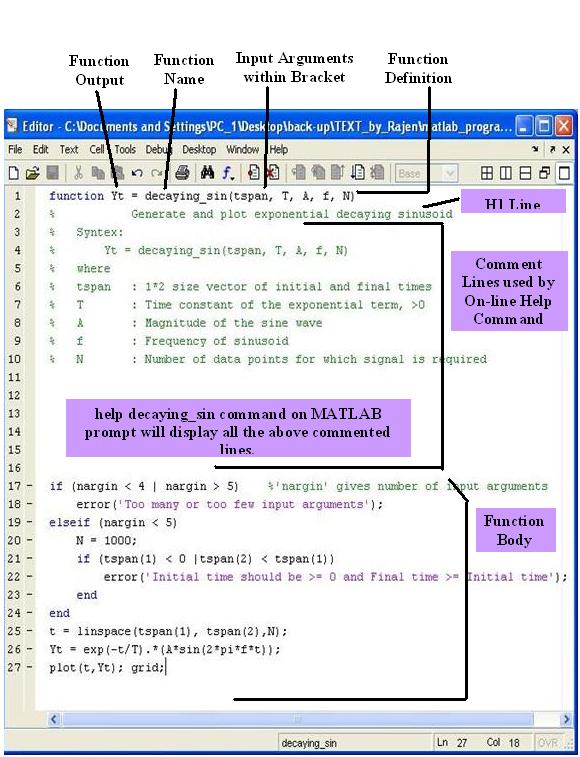MATLAB MODULE 1MATLAB Window Environment and the Base Program
Developing user-defined FunctionsSuppose you want to write a function to generate and plot N data points of the exponentially-decaying sinusoid of amplitude A, frequency f, and exponential time-constant Generate an M-file with the code given in Fig.M1.20. When you attempt to save the file, editor will automatically assign a function name decaying_sin to your M-file. Save the function to the current working directory or include your personal directory into MATLAB search path by using addpath command. We must avoid duplicating function names with built-in MATLAB functions or keywords. A function file begins with a function definition line, which contains the keyword function, a well-defined list of input and output arguments, and function name. Some examples of function definition are given below (execute help function for details): function [ph, mag] = complex (z) function [r,theta] = polar_form(a, b) function decaying_sin( ) function sys_response( ) The first commented line just after the function definition is called the H1 line. This line is automatically catalogued in the contents.m file of the directory in which function file resides. This allows the line to be searched by the lookfor command. Very carefully chosen keywords related to your function should come in the H1 line. Note that if there is any blank space before the % sign in the H1 line, then it is no longer H1 line !! All comment lines immediately following the function definition line and immediately before the first executable statement of the function are displayed by MATLAB if help is asked on the function. Type >> help decaying_sin and see what MATLAB displays. Input-argument names used in the function are local to the function; so arbitrary variable names can be used to call the function. The name of another function can also be passed as an input variable. The following are examples of legal function calls:
Fig. M1.20 DECAYING_SIN Function
>> Yt = decaying_sin (time_span, time_const, mag, freq, pts) In this case, input variables time_span, time_const, mag, freq, and pts must be defined before the function call. >> res = decaying_sin ([0 10], tau, 3, 50, 1000) Here the input variable tau must be defined beforehand; all other inputs have been defined in the function call. >> sig = decaying_sin ([0,10], 2, 3, 50, 100) Here all the inputs have been specified in the call statement. >> decaying_sin ([0,10], 3, 0.5, 60, 100) In this case, the output is assigned to generic variable ans.
|
